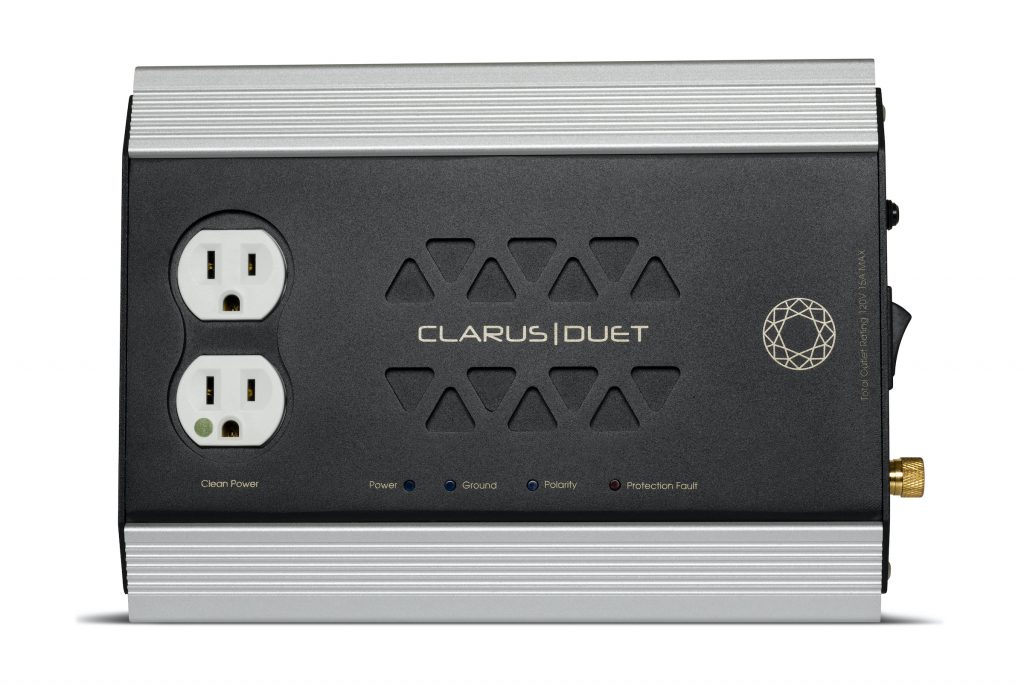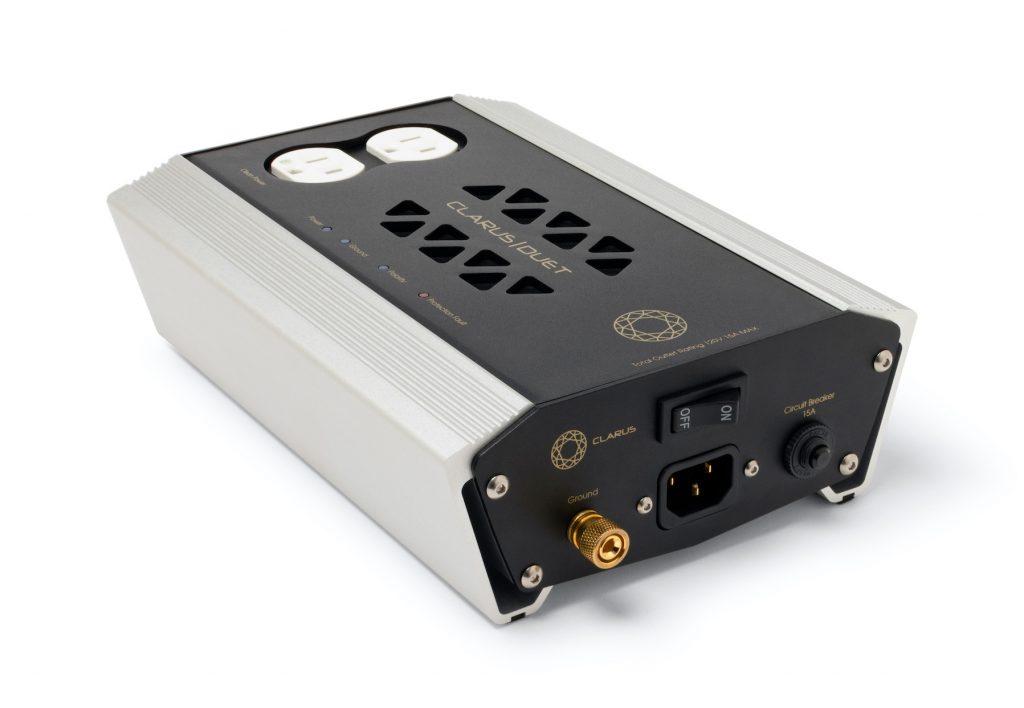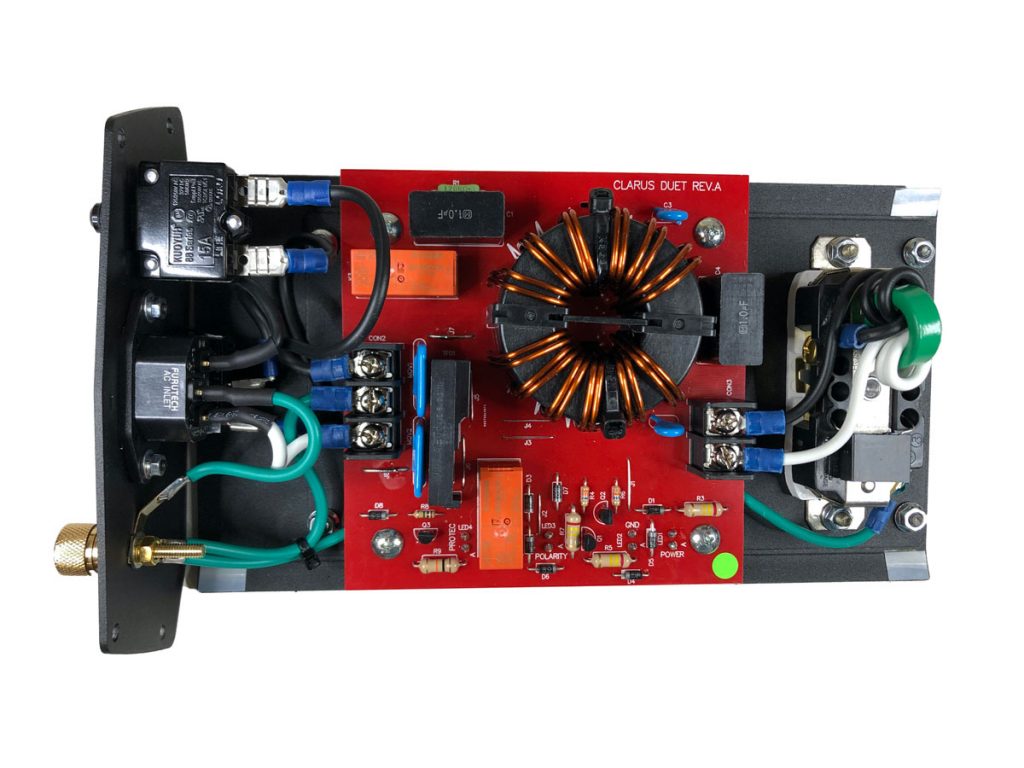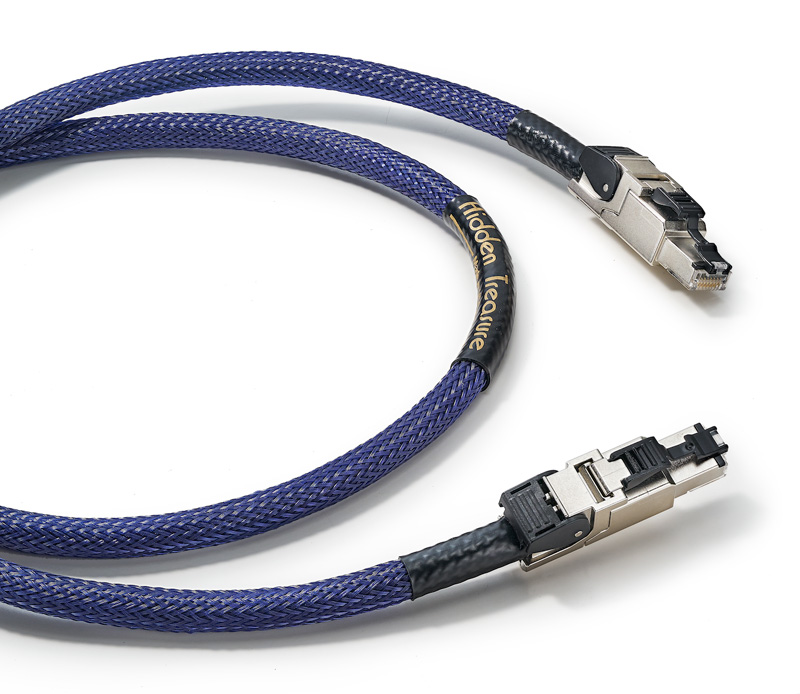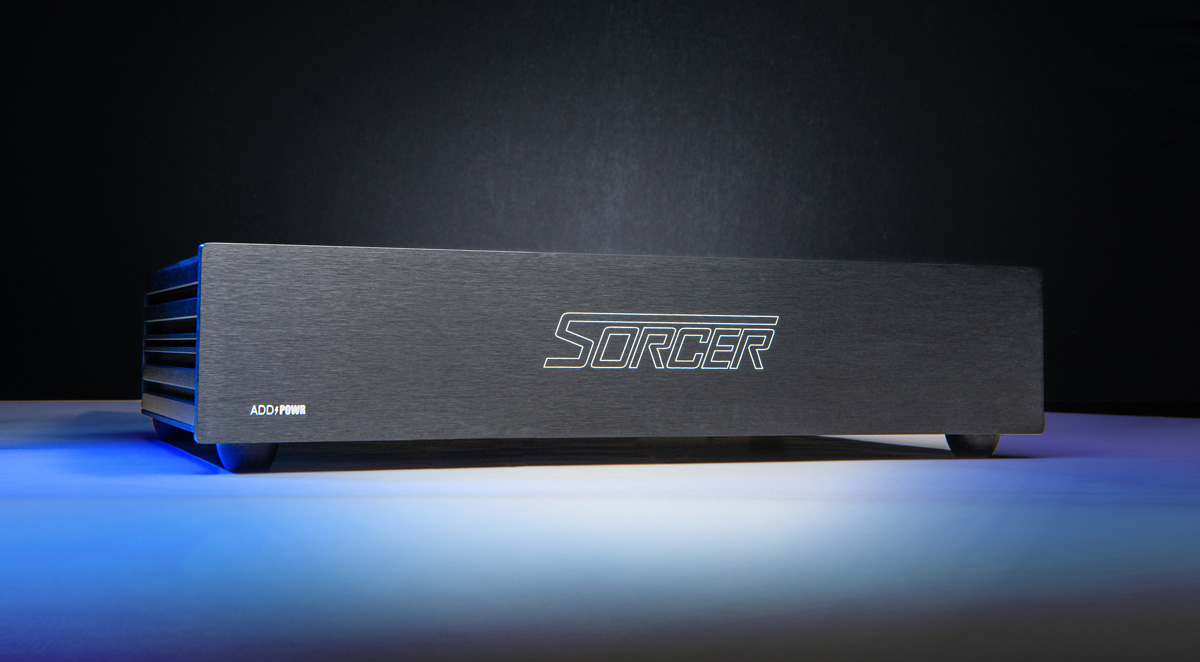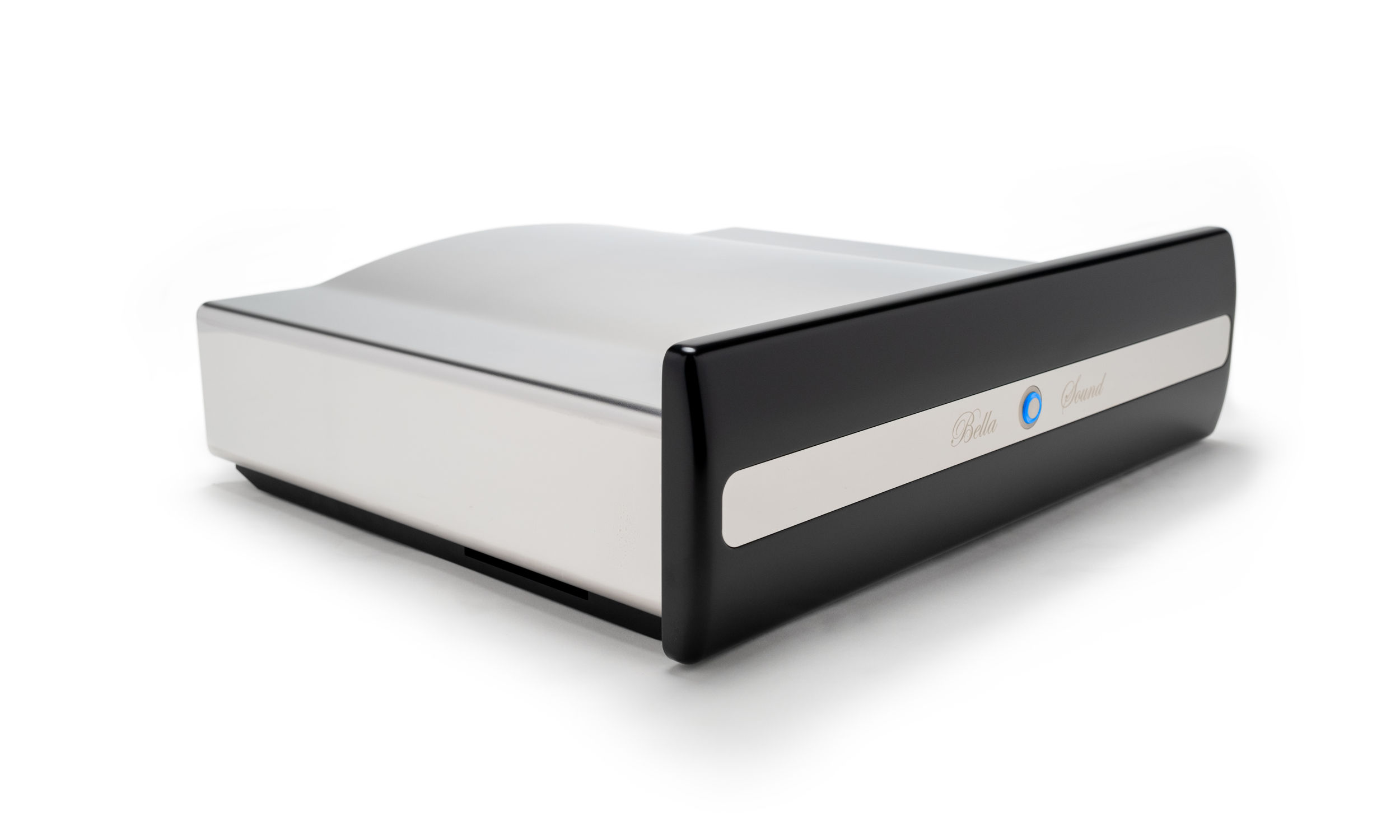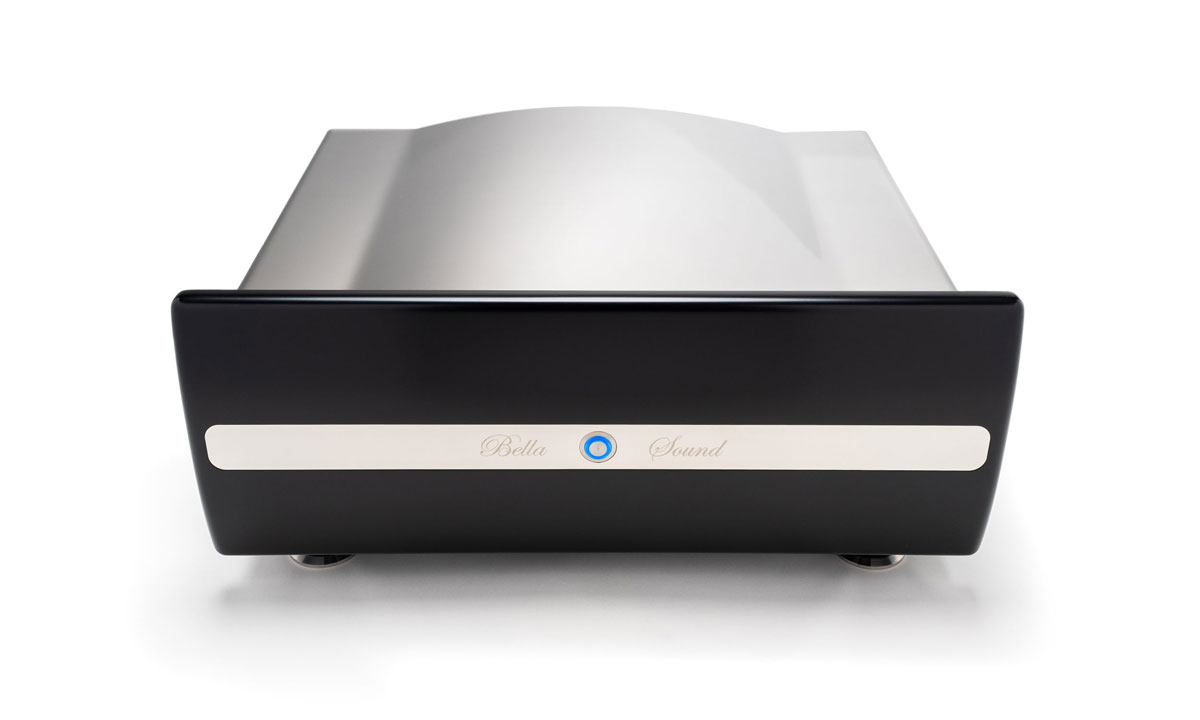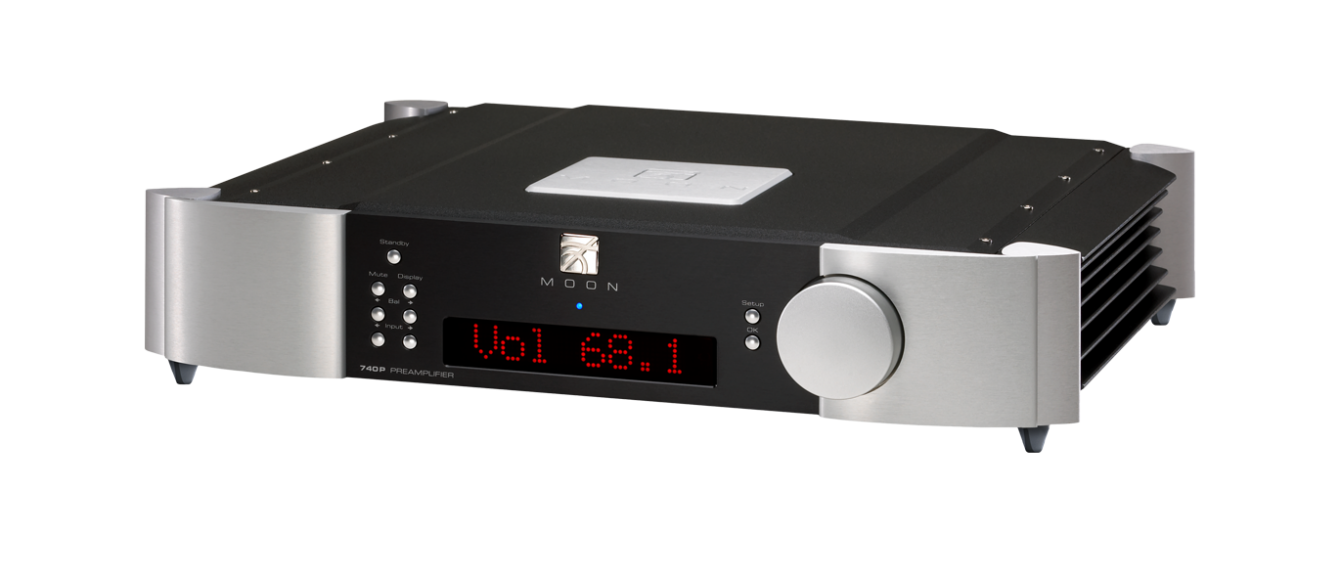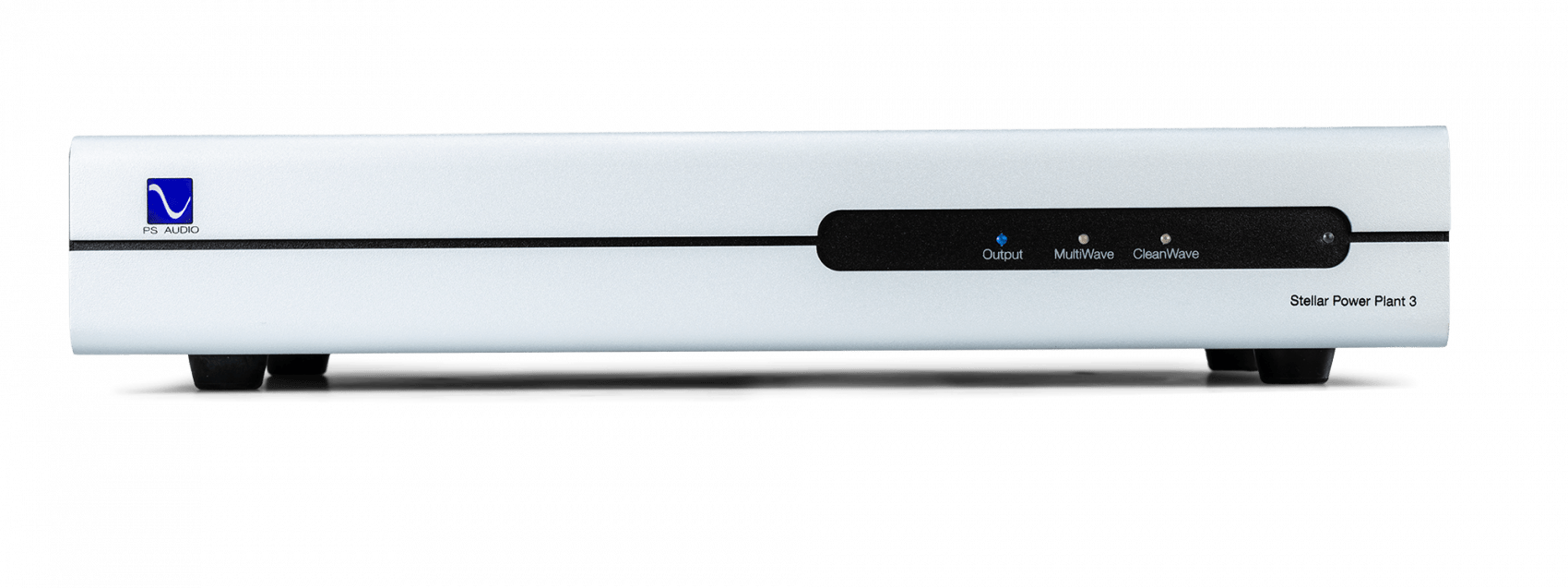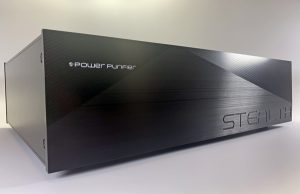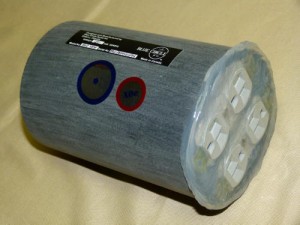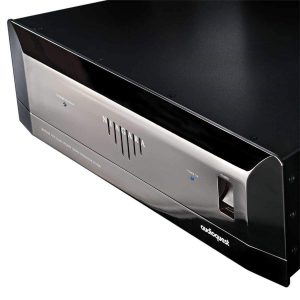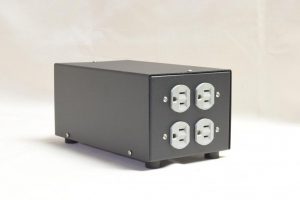Power is king. Throughout my years in audio this one thing has become clear. Power supply quality shapes the sound of a component. In order to achieve that quality, a power supply must be fed well, hence the plethora of aftermarket power cables and conditioners. The subject of this review, the Clarus Duet purports to provide a radical new approach to AC energy systems with its C-Core Technology used in all its filters. Interestingly, neither the user's manual nor the website mentions exactly what type of noise is being filtered although I am assuming it would be EMI/RFI. Also, there is limited information regarding the technical aspects of these filters, presumably because they are proprietary technologies. The unit's low magnitostriction is said to significantly reduce audible noise emission. The Duet uses Thermal Metal Oxide Varistors (TMOV) for surge protection. To all appearances the Duet is a handsome and well-engineered product.
As the name implies the Duet has two outlets. It is claimed to be designed specifically for monoblock amps and subwoofers. External features include a grounding post, main power switch, circuit breaker, and status lights for Protection Fault, Polarity, and ground, and an IEC power cord receptacle plus the afore mentioned power outlets. The power status LEDs are a welcome feature.
For this review I used a duo of Duets. I might have been better served with four Duets, but to better understand why, click on my name at the top of the review to see a description of my system. Each review sample was shipped with a Clarus Crimson power cord. These cords have an impressive look, exuding quality and craftsmanship. In fact, the cords were so impressive looking; I decided to give them a listen before installing the Duets. (More on the Clarus Duet by Michael Zisserson can be found HERE.)
The electrical code for house wiring requires a certain wire size for specific types of circuits. The most common 15 amp circuit requires 14 gauge wires. Higher current circuits require heavier gauges. It's acceptable to wire a circuit with a heavier gauge than code requires. It is against code to start at the power source with one size wire and then at some point in the circuit increase the wire size. The larger wire will handle more current and could overload the smaller wire resulting in a potential fire hazard. The reverse is, however, acceptable. In other words going from a larger to a smaller gauge is acceptable as long as the smaller gauge meets code. And yet, how many audiophiles use standard 15 amp / 14 gauge circuits and then connect heavy gauge aftermarket power cords. To address this in my own system I installed five dedicated circuits, three with 6 gauge, and two with 10 gauge wire, as well as using high quality duplex outlets. My understanding is that larger wire gauges better reject EMI / RFI interference. I also use two ground rods dedicated to my sound equipment and isolated from house ground.
The Clarus website did not have any information about the wire gauge of the Crimson power cord, although the cord itself is large in diameter. I connected the two Clarus Crimson power cords to two of my amps and had a listen. The result was rather surprising. These cords produced the most significant change to the sound of any power cords I have tried. Midrange and treble were much as before, but the bass range had what I can only describe as power density, as if power delivery or headroom (not volume) had been increased in this frequency range. This manifested itself by making the bass very full and robust. Depending on your equipment and speakers there could be useful synergy with this cord. In my setup, which is designed for full range, dynamic bass, it worked with some things. With others, however, this musical density could overshadow the soundstage slightly compared to my usual Soundstring Gen II power cord.
I've been enjoying some Hi-Rez downloads lately, some of which make interesting demo cuts. I've discovered lots of superb sound. The 24-bit, 96kHz download of Michael Jackson's last album, Invincible, comes to mind. This album is a product of the studio. It rocks, but there is no real ambiance compared to a live or on location recording. The cut "You Rock My World" has a very engaging bass line that the Clarus Crimson really grabs onto. "Diamonds on the Souls of Her Shoes" from a 24-bit, 96kHz download of the 25th Anniversary remaster of Paul Simon's Graceland didn't fair quite as well in this comparison, having a wee bit of restriction in the soundstage, but the difference is small enough you wouldn't notice it without an A/B comparison.
I was interested to see how universal this bass power density effect was so I loaned the cords to an audiophile friend to power his two amps. I was not able to hear the audition due to pandemic restrictions. To my surprise, he reported no such bass effect with his Hypex amps. One might wonder if what I was hearing was some sort of interaction between my amps and the cords but I tried it on my two Krells and my preamp with similar results.
Do do that Voodoo
When I used the Clarus Crimson cords to power the Clarus Duets and my usual power cords from the Duets to the amps, the bass effect vanished. The Duet has a low profile squarish shape that is stable in use and simple to place. Its outlets and display are easy to view and access. I started with the Duets connected to my Krell amps. From my system description and my comments above it should be apparent that current limiting is something I've attempted to address all the way back to the electrical panel. The designers of the Clarus Duet share these concerns and have designed the Duet to avoid any current bottlenecks. Some years ago I tried using a large isolation transformer between the amps and the wall but took it out when I started to notice dynamic constraints in the music. Since then I've run my amps straight from the wall outlet, not willing to put anything in the way of current delivery.
To test the degree of success Clarus has achieved with the Duet in terms of current limiting, I started with the 24-bit, 176kHz download of Santana Abraxas. The percolating drums and percussion on this album are a Hi-Rez delight. Throughout my audition of the Clarus Duet I never heard anything I would associate with dynamic compression or current limiting. I tried a 24-bit, 192kHz download of Tom Waits first album Blue Valentine as well as 24-bit, 96kHz download of the Maroon 5 album Songs About Jane, and a 24-bit, 192kHz DVD-A of Soular Energy by Ray Brown. I did also play "CD quality" music but the added resolution, lower noise floor, and increased dynamics in the Hi-Rez files aids in sorting out what's going on. My software player up-converts all files to the native rate of the DAC, either 384kHz or 376.8kHz depending on the base frequency.
The Duets noise filtration had no audible effect on the sound of my system. There are several possibilities. Maybe I just can't hear the difference. I'm old enough that I probably can't hear above 14-16K. Maybe noise levels were low enough that there was nothing left to fix, or, conversely, perhaps other noise factors elsewhere in the system swamped the benefits of the Duet. The Duet did no harm at any rate and whether I can hear it or not the cleaner power should make the amps run more efficiently. I enjoyed the opportunity to audition this solidly built and thoughtfully engineered product.
Postscript: Audience Hidden Treasure CAT 7 Ethernet cable
I picked up a couple of review samples of the new CAT 7 Ethernet cable from Audience. It is beautiful to behold. Audience is claiming a multitude of proprietary high performance design elements including high quality conductors, dielectric materials, RF blocking nano-crystals, cryogenic and high voltage treatments. I used one of my samples to connect my NAS music library to my router. From the router to my music server is a 20 foot length of generic CAT 7 connected to a galvanic isolator and then to the remaining Audience sample. I don't have enough data for a full review. Perhaps if the 20 foot cable were the same I could be more certain but at $700 per half meter, I just couldn't bring myself to ask for 20 feet.
It was really subtle, but it seemed to me that dropouts and noise were reduced with the Audience Hidden Treasure CAT 7 cable. Certainly an impressive product from looks, and build quality to performance.
Duet
Retail: $1250
Clarus Cable
Gordon J. Gow Technologies, Inc
6448 Pinecastle Blvd Suite 101
Orlando, FL 32809
888.554.2494




